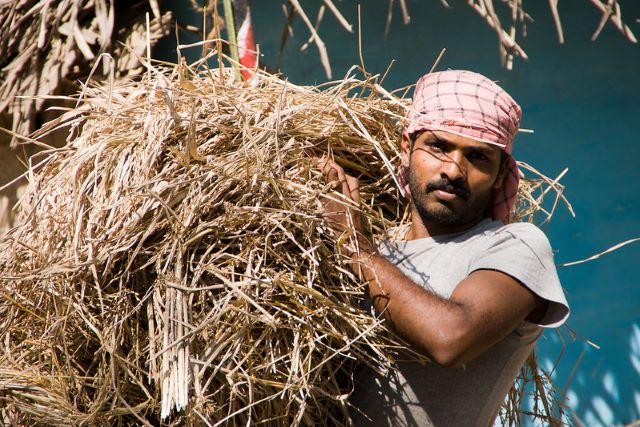 Pakistan and India are fighting a rice war, as India is attempting to gain exclusive branding rights to export basmati rice to the EU. India’s, “trademark of geographic indication” for basmati rice has been approved by the EU and Pakistan has three months to respond to this claim or they could be boxed out from exporting basmati rice to the EU. Further implications of expanding geographic indication could compromise other markets for Pakistan, yet its response so far has been slow and inconsistent. The EU’s decision will influence each country’s economy and with hundreds of millions of impoverished people between the two, there is much at stake. Rice exports are crucial to both India and Pakistan’s economies.
Pakistan and India are fighting a rice war, as India is attempting to gain exclusive branding rights to export basmati rice to the EU. India’s, “trademark of geographic indication” for basmati rice has been approved by the EU and Pakistan has three months to respond to this claim or they could be boxed out from exporting basmati rice to the EU. Further implications of expanding geographic indication could compromise other markets for Pakistan, yet its response so far has been slow and inconsistent. The EU’s decision will influence each country’s economy and with hundreds of millions of impoverished people between the two, there is much at stake. Rice exports are crucial to both India and Pakistan’s economies.
The Value of Rice in Pakistan
The basmati rice industry is one that Pakistan heavily contributes to and relies on. Pakistan contributes to 35% of global basmati rice exports and its trade to the EU have grown from 120,000 tons to 300,000 tons since 2017. A whole 40% of Pakistan’s workers are involved in agriculture, with rice accounting for 20% of agricultural land.
The Value of Rice in India
India exported 4.5 million tons of Basmati rice between 2019 and 2020, which made up 65% of global basmati rice exports. India has increased rice exports significantly from 2017 when they exported four million tons of rice. Around three-fifths of India’s basmati rice exports go to Saudi Arabia, Iraq and Iran.
Despite rice production increasing due to new practices, rice yields in both Pakistan and India are lower than the global average. Growing challenges such as drastic climate change and inclement weather can negatively influence annual rice production. Experts conclude that improving irrigation facilities and increasing the use of new technology will allow rice yields to expand.
Population Growth & Economic Contraction
Already the fifth most populous nation in the world, Pakistan is projected to grow from 220 million to 345 million by 2045. As its population continues to grow, its economy must grow at least 7% to prevent unemployment. However, in 2019, the economy contracted from 5.5% to 1.9% and this shrinkage was further exacerbated by the COVID-19 crisis. Unemployment has increased each year since 2014 and currently sits between 4% and 5%. It is imperative that Pakistan jumpstart its economy or unemployment and poverty will spread.
Poverty in South Asia
Pakistan made great strides in reducing poverty in the early 2000s but has since stalled. By 2015, roughly one in four people, or 50 million Pakistanis, lived under the poverty line, with few opportunities to turn that around.
India also has few opportunities for the poor to improve their lives as it placed 76 out of 82 countries in terms of social mobility. The lack of social mobility ensures that most people who are born poor will die poor, with minimal chances to jump to a higher social class. India suffers from severe social inequality and lack of growth in rural areas. A whole 364 million out of 1.3 billion, or 28% of the world’s poor, live in India.
However, globalization has allowed India to bring 270 million people out of poverty between 2005 and 2015. Consequently, since 1990, life expectancy has increased by 11 years, schooling years have increased by three years and India has increased its human development index to above the medium average.
Malnutrition Causes Infant Mortality
Pakistan has an alarmingly high infant mortality rate of 55 per 1000, which is twice that of India’s. This is caused by a multitude of factors, most importantly being the malnutrition of mothers and their infants. Although wheat and rice are produced in abundant quantities, one out of five Pakistanis and 44% of children under 5 suffer from malnutrition. The problem is not whether food is available but it is that food is not accessible for the poor.
Rice as a Key Export
In Pakistan, rice provides value both nutritionally and economically. Rice accounts for 1.4% of the GDP, and the traditional basmati rice makes up 0.6% of the GDP. However, most rice is sold as an export and is not used to feed hungry mouths domestically. In 2019, Pakistan exported $2.17 billion worth of rice, of which 790 million was basmati, a 25% increase from 2018.
A whole 90% of the rice grown in India is consumed domestically. Boasting the second-largest population in the world of 1.3 billion people, India accounts for 22% of global rice production but has many more people to feed than Pakistan. India is projected to produce 120 million tons of rice between 2020 and 2021 and to export 12 million tons.
Consequences of the Rice War
Basmati rice exports generate massive profits for each country. If one country were to gain an advantage over the market, it would create enormous value for the winner and dire consequences for the loser. The winner would stand to gain economically and competitively as they could increase production and profits. Additionally, increased demand for agricultural workers and production in rural areas would create revenue in historically impoverished areas.
– Adrian Rufo
Photo: Flickr
The post Pakistan and India: The Battle for Rice Exports appeared first on The Borgen Project.